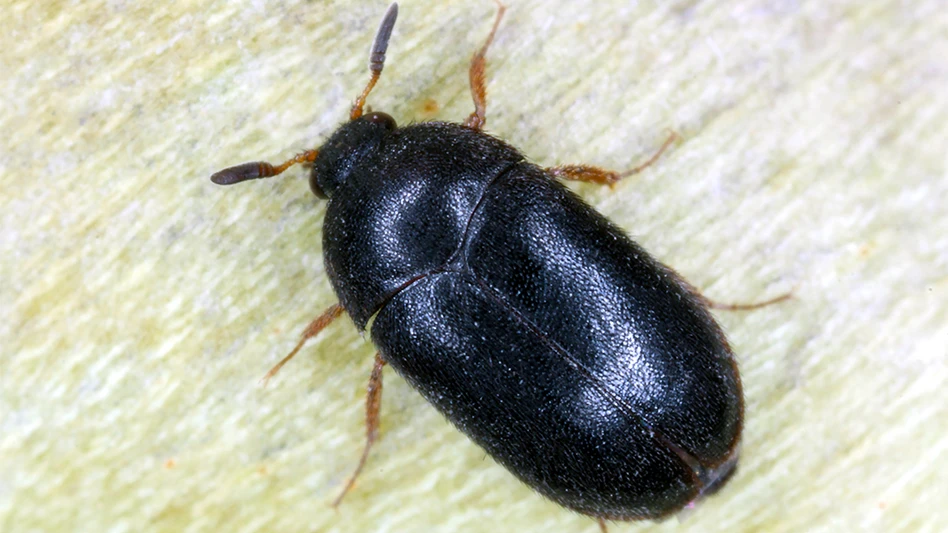Editor’s Note: The following article was adapted from Techletter, with permission from Pinto & Associates.
Carpet beetles are common on flowering plants and move from outside plants into buildings and vice versa, depending on the season. That's why to control them you may need to look further than those infested items indoors.
In early spring, newly emerged adult carpet beetles inside buildings are often noticed crawling up walls or flying to lights or windows. This happens because once the larva has pupated and turned into an adult beetle, it is attracted to light, trying to get outside to feed on flowering plants.
All of the Dermestidae carpet beetles - varied carpet beetle, black carpet beetle, common carpet beetle, furniture carpet beetle - have these same habits and the same "outdoor connection."
Habits of the Adult Carpet Beetle
Adult carpet beetles are common outdoors on flowering shrubs and plants where they feed on nectar and pollen, but don't do any visible feeding damage to the plant. Certain plants with white or cream-colored flowers seem to be more attractive to carpet beetles.
Some of their favorite flowering plants are crape myrtle, dogwood, buckwheat daisy, ceanothus, pyracantha, spirea, and wild aster.
After feeding outside on plants, the carpet beetles mate. After mating, the adult carpet beetles avoid light and may enter a home or other building. Here the female will deposit her eggs where there is an available food source for the newly-hatched larvae. After the larvae have completed development, the emerging carpet beetle adults crawl out from the wool carpet, or the lint around the baseboard, or the cat hair under the sofa wherever the larvae have been feeding. Even though the adults are very small (most of them about pin head size), they can be seen crawling up walls.
Larval Feeding and Infestation Sites
It's only the larvae that feed on carpets, fabrics (especially if soiled), hair, hides, felt, dead animals and insects, and occasionally on stored food. As you can imagine, Dermestidae carpet beetles can be serious pests in museums, insect collections, textile plants, and other sites that house fabrics or animal artifacts.
In homes, the larvae can be found on the underside of wool carpets, along baseboards, behind furniture, in voids--wherever hair, lint, dead insects and crumbs accumulate. Look for them also in stored woolens, stuffed furniture, stuffed animals, in dry pet food, and in the nests of various animals, including birds, wasps, and bees. So, plants are not the only outdoor connection. Insect and animal nests can contain carpet beetles, too.
Carpet beetle larvae can be difficult to find and control because they are often hidden and protected in dark cracks, crevices, and out-of-the-way sites. They are usually less visible to a customer than the adult beetle. Larvae may first be noticed when someone finds a pile of their shed skins under an infested item.
What Do They Look Like?
The three smaller carpet beetles (varied, furniture, and common) look much alike. The adults are small, 1/16 to 1/8-inch (2-3.5 mm) long, and rounded in shape. Each species has a different pattern of "calico" coloration; splotched with patterns of black, brown, white, reddish-orange, or yellow. When viewed under magnification, they are quite colorful. The related black carpet beetle is dark and more elongate in shape. Carpet beetle larvae are yellow-brown, about 1/4-inch (5 mm) long, and covered with bristly hairs.
Homes with pets are probably more at risk of carpet beetle infestation because of the accumulation of overlooked pet hair along baseboards, under furniture, etc. Frequent and thorough vacuuming will help to prevent and remove carpet beetle infestations.
If you have a customer with a recurring carpet beetle problem, it may not be that you've missed something inside. It could be that the beetles are reinfesting from flowering plants outside. In some cases, the unsuspecting homeowner may even carry the beetles inside on cut flowers from the yard. Customers with recurring problems might want to move flowering shrubs away from the building.
The authors are co-owners of Pinto & Associates.







